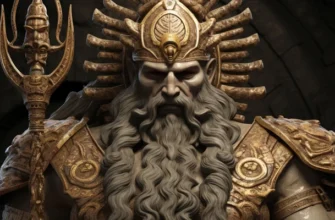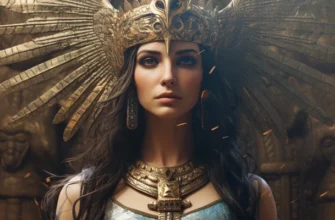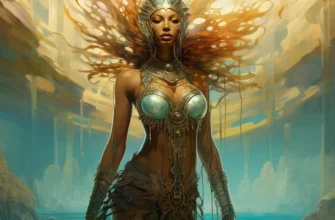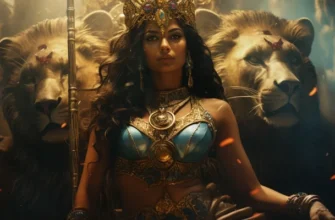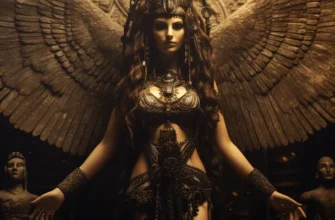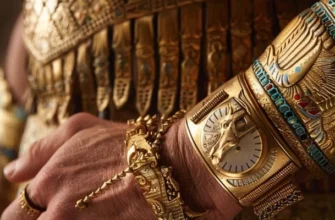The Sumerians, one of the oldest civilizations, based their mythology on a powerful god, Enlil. This god, the ruler of heaven and earth, occupied a key place in the pantheon. Enlil is known as the creator of the world and the ruler of human destiny. His cult combined rituals and shrines, and the legends about him reflected important aspects of Sumerian life. Even in modern times, Enlil leaves his mark on literature and art, inspiring interest in the ancient mysteries of this fascinating culture.
Genealogy and origins
Enlil was born in the Sumerian pantheon as the son of Anu, the supreme god of the heavens, and Ki, the goddess of the earth. His birth determined his superior status and important role in the deity structure.
Brothers and Sisters
His family consisted of other important gods, such as Ea (Eya), the god of water and wisdom, and Enki, the god of wisdom and reason. Family ties determined the interaction between the gods and their roles in the creation of the world.
Enlil’s genealogy played a key role in the structure of Sumerian mythology, shaping beliefs and stories that pointed to his greatness and power among the other gods.
Creator and Ruler
Enlil played a key role in Sumerian mythology as the creator of the world. He not only created the other gods, but also determined their duties and purposes. His decisions influenced the structure and order of the universe.
Lord of Heaven and Earth
Enlil had extraordinary power over the heavens and the earth. His greatness and power were determined by his ability to control natural forces and determine the fate of people. He was the supreme judge and determined the development of civilization.
Legends and Myths
Various mythological stories reflected Enlil’s role in the creation of the world and his interaction with other gods. These legends revealed his importance to Sumerian society and provided a religious explanation for natural phenomena.
A selection of Fascinating Legends
The Creation of Humans: In one myth, Enlil is involved in the creation of humans. He forms them from clay and gives them life and intelligence.
The message of the Great Flood: Enlil plays a key role in the famous legend of the great flood. He decides to destroy humanity because of its iniquity by warning one righteous man of the coming flood.
Conflict with Enki: The myths describe a conflict between Enlil and his brother Enki that leads to important events in Sumerian mythology.
Enlil as Judge and Punisher
In many stories, Enlil acts as a judge, determining the fate of gods and humans. His decisions can lead to reward or punishment, making him a crucial figure in the moral aspects of mythology.
The myths of Enlil help to reveal the core values and beliefs of the Sumerians, reflecting his power, wisdom, and interaction with other deities.
Enlil stands out among the other gods of the Sumerian pantheon as the ruler of heaven and earth. He occupied a supreme position, united by his dominion over the heavens and the earth, which defined him as a key figure in Sumerian mythology.
Creator and Protector
Enlil was considered the creator and ruler of everything that exists. His power extended to the creation of the world and the appointment of other gods. He acted as a protector and patron, interacting with the deities to ensure the order and fate of the universe.
Enlil had power over natural elements such as wind, storms, and thunderstorms. This made him not only the creator but also the controller of nature, which defined him as an essential aspect of the Sumerian cosmos.
Enlil’s role as ruler of heaven and earth defined Sumerian culture and social order. His cult was an important part of daily life, influencing religious rites, rituals, and moral values of the civilization.
Role in the Sumerian pantheon
Supreme ruler
Enlil acted as the supreme ruler in the Sumerian pantheon. His position was the highest among the other gods, giving him undisputed power over all life and the world.
Creator and Judge
In his role as creator, Enlil created not only the world but also other gods and people. His decisions influenced all aspects of life, determining the fate and duties of each deity.
Defender of Morality and Order
Enlil acted as a guardian of morality and order in the Sumerian worldview. His judgment regulated the lives of gods and people, imposing punishment for violations of norms and values.
Participation in Mythical Events
In the mythological narratives, Enlil participated in key events, interacting with other gods and influencing the course of the myths. His role reflected his importance to the structure of Sumerian mythology.
Cult and Worship
The cult of Enlil was an important element of Sumerian religious life. Shrines dedicated to him played a role in religious rites and festivals, and his influence flowed into everyday aspects of Sumerian society.
Interaction with other gods
Conflicts with Enki
Enlil’s interaction with his brother Enki often manifested itself in conflict. The rivalry between them created dramatic scenarios in Sumerian mythology, influencing the course of events and the development of civilization.
Cooperation in the Creation of the World
Although there were conflicts, Enlil collaborated with other gods, particularly Enki and Ea, in creating the world and defining the roles of other deities. This collaboration determined the balance and order in the Sumerian pantheon.
Involvement of Other Gods in Mythical Events
In mythological stories, Enlil often interacted with other gods to achieve common goals or solve problems. His role in these events reflected his relationships and interactions with other members of the pantheon.
Enlil’s decisions and interactions with other gods not only determined the fate of other deities, but also influenced the human world. His judgments determined the events and development of both spheres of life in Sumerian mythology.
Role in the Pantheon
Enlil acted as a central figure who ensured unity and order in the pantheon. His influence and interaction with other gods shaped the main aspects of the religious and mythical worldview of the Sumerian people.
Shrines and Temples
The cult of Enlil was manifested in large shrines and temples where religious rites and sacrifices were performed. These shrines served as a center of worship and interaction with the ruler of the heavens.
Rites and Rituals
Religious practices associated with Enlil included specific rituals, prayers, and sacrifices. People paid homage to Enlil, hoping for his blessing and protection.
Role in Social Life
The cult of Enlil contributed to the social aspects of Sumerian society. Leaders and rulers used his cult to assert their power and legitimize their actions.
Participation in festive events
The festivals dedicated to Enlil were important events in the religious calendar. Special festive rituals and parades celebrated his greatness and power, attracting large numbers of believers.
Influence on Art and Culture
The cult of Enlil had a significant impact on Sumerian art and culture. His images were reflected in sculptures, drawings, and literary works, which helped to establish his religious definition in the artistic and cultural context.
Enlil in modern times
Literature and Art
The image of Enlil and Sumerian mythology are reflected in contemporary literature and art. Authors and artists use his character to create fantastic and artistic works.
Study and Research
Religious historians and archaeologists continue to study Sumerian mythology, including the role of Enlil. New research may reveal new aspects of his importance to ancient society.
Religious Communities
In some modern religious communities that value ancient beliefs, the cult of Enlil may find its place. It can serve as an object of worship in reenactments or spiritual practices.
Influence on Pop Culture
Characters and mythological stories associated with Schumer and Enlil often appear in popular culture. They can serve as a source of inspiration for movies, video games, comics, and other entertainment formats.
Discussion in Educational Contexts
Enlil and Sumerian mythology have been discussed in educational contexts. Studying this topic helps to understand the contribution of ancient beliefs to cultural heritage and religious practices.
Conclusion
Enlil, as the supreme god in Sumerian mythology, was not only the creator and ruler of the heavens and the earth, but also a key figure in shaping the worldview and cultural heritage of Sumer. Belief in him contributed to the creation of complex religious rites and rituals, and his images were reflected in art and literature. Modern studies and discussions of Sumerian beliefs help to reveal the general essence of his role in shaping human history, noting the importance of this aspect in the development of religious and cultural practices. Enlil’s legacy, embodied in artifacts, texts, and rituals, is not only an important component of archaeological research, but also a key to understanding the development of other religions and cultures in human history.

